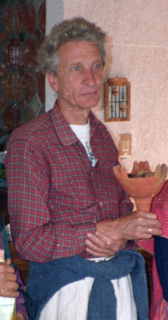Article begins

Image description: A grey-haired man stands with his arms in front of him, one hand holding an item made of clay. He wears a red, plaid, long-sleeved shirt and khakis with a blue jacket tied around his waist.
Caption: Robert M. Laughlin.
1934–2020
Robert Laughlin (May 29,1934–May 28, 2020), lexicographer extraordinaire of the Tzotzil (Mayan) language of Chiapas, Mexico; indefatigable student of the natural, social, and dream worlds of its speakers; and committed advocate for their literary, dramatic, and artistic pursuits, was for his entire academic career curator of Mesoamerican ethnology at the Smithsonian Institution. He succumbed to COVID-19 in Alexandria, Virginia, the day before his 86th birthday.
Laughlin’s monumental Great Tzotzil Dictionary of San Lorenzo Zinacantán (1975) remains the largest and most ethnographically acute dictionary of an Indigenous American language, living or dead. He began with stories and dreams recounted by Zinacantec elders (later published as separate volumes). Reducing these texts to index cards, Laughlin and two limitlessly patient Zinacantec compadres tested derived forms of all possible Tzotzil monosyllabic roots to weed the wheat of recognizable words from the chaff of nonsense. The result, produced over 16 years, harvested over 30,000 words, but also grammatical insights, speech “categories” (including male or female, joking, denunciatory, ritual speech, and baby talk), ethnographic lore (plant uses, recipes, food properties and prohibitions, farming techniques, omens, illnesses, afflictions of the soul), and exemplary snippets of natural talk.
Hoping to escape lexicography, Laughlin nonetheless could not resist painstakingly reconstructing a colonial-era Tzotzil manuscript, found among the rare books at Princeton University, which over the next decade became The Great Tzotzil Dictionary of Santo Domingo Zinacantán (1988). He eventually also published a Spanish translation of the modern dictionary as El Gran Diccionario Tzotzil de San Lorenzo Zinacantán (2007), incorporating rural Chiapas Spanish vernacular.
Laughlin’s ethnobotanical masterpiece The Flowering of Man (1993, coauthored with Dennis Breedlove) was to Zinacantecs’ knowledge of plants what his lexicographic endeavors were to their words. Producing it took him and his compadres away from conversations, jokes, and prayers to gardens, fields, and treetops throughout Chiapas to identify specimens.
These major works, together with his collections of legends, dreams, reminiscences, and prayers constitute one of the most important and well-documented records of any American language from both hemispheres. Tzotzil is replete with both cosmovision and poetry—doubtless what drew it into Laughlin’s heart.
Laughlin’s books sparkle with wit and thoughtfulness, touching on topics as diverse as what makes lexicographers tick; how systematic (or anarchic) our understanding of words is; who the sixteenth century friar who learned Tzotzil so astonishingly well might have been; or how the themes of Zinacantec tales, collected over six decades, resonate with many other mythic traditions. Laughlin’s work has also nourished the language itself, contributing to everything from the decipherment of Mayan hieroglyphs to the modern explosion of Tzotzil literature, art, music, and video. Perhaps most central to his legacy, in the mid-1980s Laughlin and his closest Tzotzil kin founded Sna Jtz’ibajom (The Writers’ House), a collective dedicated to literacy, literature, and theater. Sna won Mexico’s National Prize in Sciences and Arts in 2004. It continues the work of Lol Bik’it Nab—the name by which Laughlin is best remembered by his legions of Mayan friends.
(John B. Haviland)
Cite as: Haviland, John B. 2021. “Robert M. Laughlin.” Anthropology News website, January 6, 2021. https://doi.org/10.14506/AN.1562

